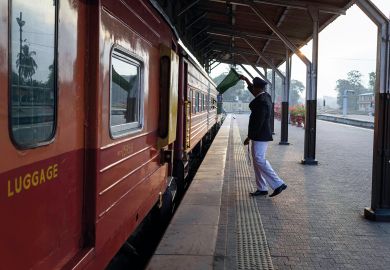Around 40 writers from a range of academic disciplines have contributed to these four collections on the experience and meanings of migration. Most chapters relate to migration from India and other South Asian countries, the last region to take a major share of world population movements, but the themes explored should interest almost any social scientist and historian.
What emerges from almost all the contributions is the extent to which migration is a key element in the modern world. It is also a process of great creativity. Cultural institutions travel with the migrants and are adapted by them to new economic and political conditions, new groups emerge in the process of migration itself, while individuals have some degree of choice over how to manage their identities within their new environments.
Desh Pardesh and Nation and Migration deal only with groups that came from South Asia (though in some cases via East Africa or the Caribbean) and Migration: The Asian Experience predominantly so, while Migration and Identity is more varied but has a Latin American emphasis. Desh Pardesh looks only at groups settled in Britain, while Nation and Migration covers Britain, the United States, Fiji and the Caribbean. These two books are chiefly the work of anthropologists and religious studies specialists, while Migration and Identity draws for the most part on social historians and literature specialists, and Migration: The Asian Experience includes all of these disciplines and others. With the exception of a couple of overviews in this last book, all the chapters are based upon intensive case studies of particular groups, generally through participant observation or the techniques of oral history. Migration and Identity also includes an interview with Homi Bhabha in which he speaks both of his own experiences and of his reflections on racism and identity in Europe and North America. Individual chapters in all four volumes are of outstanding quality, and there are no disasters, but on the whole the greater coherence of Desh Pardesh and Nation and Migration gives them the edge over the other two.
Migration is not easy to define. A degree of movement over a wide territory is normal for pastoralists, seasonal labourers, mercenary soldiers, seamen and many others. Temporary movements may become permanent for a number of reasons. In California in the early 20th century, as in post-1962 Britain, legislation may play an important part in freezing movement (Roger Daniels in Migration). Since the end of the second world war, there has usually, but not always, been a negative correlation between rates of unemployment in Britain and the level of migration from South Asia (Ceri Peach in Migration). It is not, however, the poorest who migrate but those who have the initial resources to finance the passage and other initial costs.
But there is much more to say about the decision to move. Marcus Banks's contributions (in Desh Pardesh and Migration) point out, for example, that among some Jain groups migration has been going on at least since the 16th century, first from Rajasthan to Saurashtra, then to East Africa and more recently to Leicester. In Barbados many families, in the words of one of those interviewed by Mary Chamberlain (in Migration and Identity) "love to travel", and have done so earlier to Panama, Trinidad, Cuba and Curacao. Some individuals act as pioneers, facing both the hardships but also perhaps the excitements of exploring new territory, while soon bringing over not just their own family members but also more distant relatives and contacts in a process of "chain migration" described in a number of articles.
Immigrant groups make use of their cultural capital to establish social and cultural institutions for themselves. Kinship networks were deeply involved in many of the initial movements and they continue to structure many people's lives. However, while in the initial stages of the migration process individuals remained tightly bound to "home" through family ties and remittances, as families reunited and brought up children and then grandchildren in a British or American setting, the dynamics of kinship became more complex. Although, for example, the kinship network or biradari exercises a conservative and stabilising influence within the lives of Pakistanis in Oxford (Alison Shaw in Desh Pardesh), especially through its role in establishing marriage alliances, it is itself flexible and evolving. New biradari links are established on the basis of shared experiences in the new country. Pnina Werbner (in Migration) explores this theme in the specific context of entrepreneurial activity in the Manchester rag trade, where Pakistani businessmen have revitalised this section of the local economy. While biradari links were formerly important here, the larger and more sucessful firms have now moved beyond them. Werbner has an interesting discussion on which types of business information are shared within the community and which are not.
Groups which in 1950s and 1960s Britain might have shared common places of worship faute de mieux, now have the resources to build their own. But this is not necessarily just a matter of convenience: it may reflect concerns for recognition and status that were denied in the South Asian context. Eleanor Nesbitt's discussion (in Desh Pardesh) of a group in Coventry illustrates this well. As Valmikis, they had occupied a very demeaning position in the villages of Punjab and had sought various ways in which to raise their status. In Britain, too, life has hardly been easy but there was more opportunity to establish a distinct and separate identity. But Nesbitt suggests that this too will be a transitional phase and that the British-born generation will be as likely to see themselves as Punjabi as Valmiki.
Identities are thus contingent, variable and layered, a point made repeatedly by contributors to all the volumes. A good example is provided by the question of Sikh identity. Verne Dusenbery (in Nation and Migration), using an ethnosociological approach, discusses the history of Sikhs in North America, which goes back to the late 19th century, and suggests that initially they travelled as Punjabis who happened to be Sikh. It was only later that developments in India and more recently in the countries of settlement led to a greater concentration on the Sikh element of identity. Below that level, however, other identities come into play, which encode group histories of migration and settlement, and which play major roles in such matters as marriage. A second- or third-generation Sikh living in Vancouver is perceived by himself and by others as distinct from a Sikh living in Birmingham or in Jullundur.
Identities require occasions for public display, not least in the form of claims to space and recognition, and several writers give examples. The most striking is Susan Slyomovics's account (in Nation and Migration) of the Muslim World Day parade in New York. This annual event is now part of the city's calendar of marches, and as such fits a set pattern, including Irish marching bands playing Yankee Doodle alongside sufi groups and floats carrying models of religious symbols such as the Kaaba. But the price to be paid is the acceptance of the larger society's classification of Muslims as an ethnic group. Sally Westwood's piece (in the same book) discusses football as a means whereby young South Asians have asserted their identity as young male members of the black community through control of space.
Four of the chapters in Nation and Migration deal with Indian migration to the Caribbean and Pacific. The story of indentured labour, described elsewhere by Hugh Tinker as "a new system of slavery", has been told before, but these chapters focus directly on how new identities were created in conditions where direct contact with the sending society was difficult, intermittent and conditioned by the imperial connection. Recruited from many different areas of India, the indentured labourers who chose to stay on at the end of their contracts had to engage in an act of collective imagining to create cultural identities for themselves. While there was a clear sense that people were either "Hindu" or "Muslim" by descent, these labels themselves were very fluid. There was, however, no shortage of people to lay down the law as to what the labels meant and should mean, as Madhavi Kale's study shows. Following disturbances at the Hosay or Muhurram celebrations in 1884, the Trinidad government turned to Sir H. W. Norman, governor of Jamaica and also a former Indian army officer, who pointed out that "some of the most respectable Mahomedans in the Island" held aloof from the procession, and that most of the participants were in any case Hindu. At a later stage the Hindu population organised itself at the island level, so that a form of "orthodoxy" emerged. More recently, there have been efforts from outside to conduct missionary work among the Hindus of this first diaspora. John Kelly's article on Fiji details the work of the Sai Baba organisation and the International Society for Krishna Consciousness, both of which project a vision of devotional religion. The leadership of ISKCON in the Pacific region is in fact in the hands of American and Australian devotees. Steven Vertovec examines the position of Indo-Caribbeans in Britain, where they have developed their own religious and social centres. While many of the younger generation, Vertovec says, are able successfully to operate in both British South Asian and Caribbean contexts, the older generation preserve an attachment to the specificities of Indo-Caribbean culture.
Only one of the four volumes uses the word diaspora in its title (although several individual articles also do so), yet clearly all contribute to diaspora studies. But how appropriate is the term at all, with its emphasis on dispersion and eventual return? What emerges from these four volumes is an emphasis on the way new identities are forged in the countries of settlement. It is, however, by no means necessary that one identity wholly replaces another - quite the contrary. As Roger Ballard argues in the Introduction to Desh Pardesh, the second generation especially have become skilled navigators, switching codes as they move from context to context. One of those contexts is of course that of racial exclusionism, although this is hardly the undifferentiated phenomenon that some of the contributors claim. It will in the short term restrict the options available to the next generation, but over the years the South Asian contribution to the British economy and to its cultural life will become even more varied.
David Taylor is senior lecturer in politics, School of Oriental and African Studies, University of London.
Migration: The Asian Experience
Editor - Judith M. Brown and Rosemary Foot
ISBN - 0 333 60100 9
Publisher - Macmillan
Price - £40.00
Pages - 262
Register to continue
Why register?
- Registration is free and only takes a moment
- Once registered, you can read 3 articles a month
- Sign up for our newsletter
Subscribe
Or subscribe for unlimited access to:
- Unlimited access to news, views, insights & reviews
- Digital editions
- Digital access to THE’s university and college rankings analysis
Already registered or a current subscriber? Login



